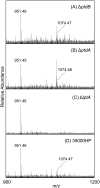Phosphoethanolamine Transferase LptA in Haemophilus ducreyi Modifies Lipid A and Contributes to Human Defensin Resistance In Vitro
- PMID: 25902140
- PMCID: PMC4406763
- DOI: 10.1371/journal.pone.0124373
Phosphoethanolamine Transferase LptA in Haemophilus ducreyi Modifies Lipid A and Contributes to Human Defensin Resistance In Vitro
Abstract
Haemophilus ducreyi resists the cytotoxic effects of human antimicrobial peptides (APs), including α-defensins, β-defensins, and the cathelicidin LL-37. Resistance to LL-37, mediated by the sensitive to antimicrobial peptide (Sap) transporter, is required for H. ducreyi virulence in humans. Cationic APs are attracted to the negatively charged bacterial cell surface. In other gram-negative bacteria, modification of lipopolysaccharide or lipooligosaccharide (LOS) by the addition of positively charged moieties, such as phosphoethanolamine (PEA), confers AP resistance by means of electrostatic repulsion. H. ducreyi LOS has PEA modifications at two sites, and we identified three genes (lptA, ptdA, and ptdB) in H. ducreyi with homology to a family of bacterial PEA transferases. We generated non-polar, unmarked mutants with deletions in one, two, or all three putative PEA transferase genes. The triple mutant was significantly more susceptible to both α- and β-defensins; complementation of all three genes restored parental levels of AP resistance. Deletion of all three PEA transferase genes also resulted in a significant increase in the negativity of the mutant cell surface. Mass spectrometric analysis revealed that LptA was required for PEA modification of lipid A; PtdA and PtdB did not affect PEA modification of LOS. In human inoculation experiments, the triple mutant was as virulent as its parent strain. While this is the first identified mechanism of resistance to α-defensins in H. ducreyi, our in vivo data suggest that resistance to cathelicidin LL-37 may be more important than defensin resistance to H. ducreyi pathogenesis.
Conflict of interest statement
Figures





Similar articles
-
Interactions of the Skin Pathogen Haemophilus ducreyi With the Human Host.Front Immunol. 2021 Feb 3;11:615402. doi: 10.3389/fimmu.2020.615402. eCollection 2020. Front Immunol. 2021. PMID: 33613541 Free PMC article. Review.
-
Haemophilus ducreyi SapA contributes to cathelicidin resistance and virulence in humans.Infect Immun. 2010 Mar;78(3):1176-84. doi: 10.1128/IAI.01014-09. Epub 2010 Jan 19. Infect Immun. 2010. PMID: 20086092 Free PMC article.
-
Deletion of mtrC in Haemophilus ducreyi increases sensitivity to human antimicrobial peptides and activates the CpxRA regulon.Infect Immun. 2011 Jun;79(6):2324-34. doi: 10.1128/IAI.01316-10. Epub 2011 Mar 28. Infect Immun. 2011. PMID: 21444663 Free PMC article.
-
Permeases of the sap transporter are required for cathelicidin resistance and virulence of Haemophilus ducreyi in humans.J Infect Dis. 2012 Nov;206(9):1407-14. doi: 10.1093/infdis/jis525. Epub 2012 Aug 28. J Infect Dis. 2012. PMID: 22930807 Free PMC article.
-
Chancroid and Haemophilus ducreyi: an update.Clin Microbiol Rev. 1995 Jul;8(3):357-75. doi: 10.1128/CMR.8.3.357. Clin Microbiol Rev. 1995. PMID: 7553570 Free PMC article. Review.
Cited by
-
Interactions of the Skin Pathogen Haemophilus ducreyi With the Human Host.Front Immunol. 2021 Feb 3;11:615402. doi: 10.3389/fimmu.2020.615402. eCollection 2020. Front Immunol. 2021. PMID: 33613541 Free PMC article. Review.
-
Structural characterization of phosphoethanolamine-modified lipid A from probiotic Escherichia coli strain Nissle 1917.RSC Adv. 2019 Jun 25;9(34):19762-19771. doi: 10.1039/c9ra02375e. eCollection 2019 Jun 19. RSC Adv. 2019. PMID: 35519361 Free PMC article.
-
The role of bacterial transport systems in the removal of host antimicrobial peptides in Gram-negative bacteria.FEMS Microbiol Rev. 2022 Nov 2;46(6):fuac032. doi: 10.1093/femsre/fuac032. FEMS Microbiol Rev. 2022. PMID: 35749576 Free PMC article. Review.
-
Efficacy of Antigonococcal CMP-Nonulosonate Therapeutics Require Cathelicidins.J Infect Dis. 2020 Oct 13;222(10):1641-1650. doi: 10.1093/infdis/jiaa438. J Infect Dis. 2020. PMID: 32692363 Free PMC article.
-
Conformational flexibility of EptA driven by an interdomain helix provides insights for enzyme-substrate recognition.IUCrJ. 2021 Jul 15;8(Pt 5):732-746. doi: 10.1107/S2052252521005613. eCollection 2021 Sep 1. IUCrJ. 2021. PMID: 34584735 Free PMC article.
References
Publication types
MeSH terms
Substances
Grants and funding
LinkOut - more resources
Full Text Sources
Other Literature Sources
Medical
Miscellaneous

